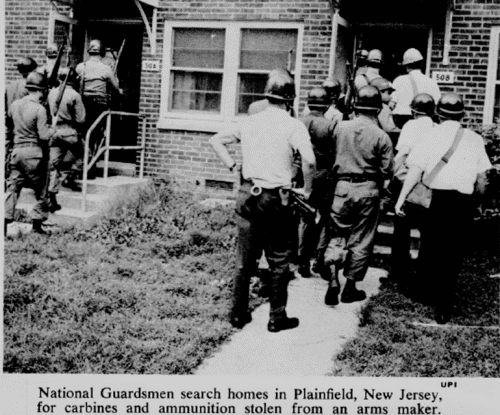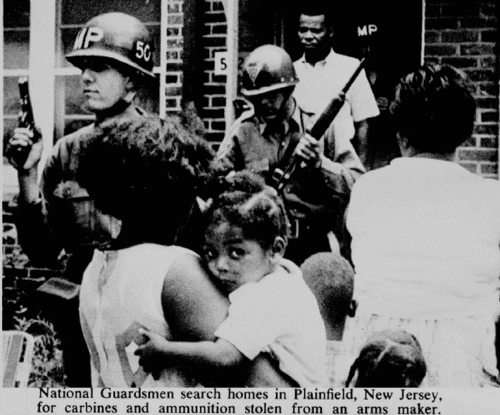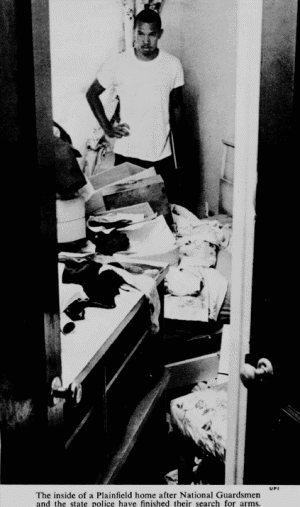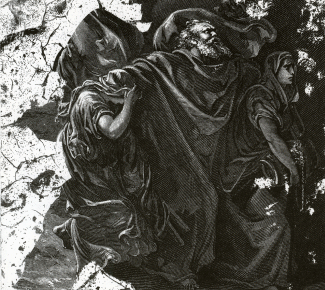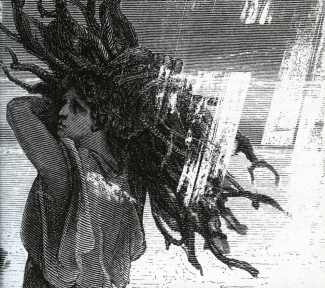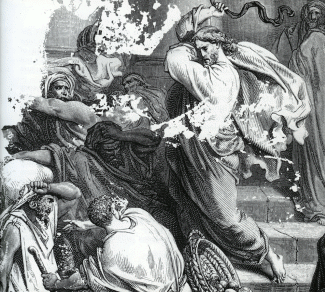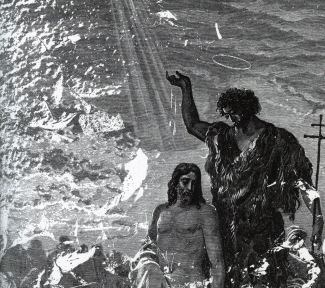THE VIRTUAL LEGALIZATION OF DRUGS -- OPEN- AIR DRUG MARKETS
Open-air drug markets are the most visible sign of the acceptance of the drug trade in our nation. It is a national disgrace that such markets are tolerated in virtually every major American city. Where they exist, crime, victimization, and addiction flourish. Yet many communities have demonstrated that forcing drug dealers from open spaces makes their lives more difficult and dangerous and hence their activities less frequent.
One such community success story is that of the Miami Coalition. It has helped organize a wide range of local anti-drug activities, not the least of which was pressing Dade County officials to demolish more than 2,000 crack houses. The coalition claims that crime in the area has been reduced by 24 percent and annual drug use has decreased by 40 percent as a result of its efforts. [63]
Another success story is the Safe Streets Campaign in Tacoma, Washington. It has involved 8,000 community members, including 2,000 young people, in its activities (i.e., closing down local drug markets and neighborhood prevention efforts). The campaign, formed in 1989, claims to have closed over 600 drug markets, reduced 911 calls by 23,000, and removed all graffiti from the more than 3,000 blocks it has organized. [64]
And in San Antonio, Texas, San Antonio Fighting Back has created a partnership between the community and the police to fight crime and drugs. Burglaries decreased by 19 percent and auto theft by 23 percent in one year. Resident reports to police of criminal activity increased substantially. Eighty-five crack houses have been closed, and an abandoned nursing home that became a haven for transients, drug users, and criminals on the run was demolished. A special effort for young people called Mentors Fighting Back claims to have substantially reduced criminal behavior, improved student attendance by 25 percent, and improved student grades by 30 percent. [65]
Throughout the nation thousands of neighborhoods and communities have organized themselves to confront street crime, drug dealing, and drug use. They range in sophistication from little more than neighborhood watch efforts to large programs including prevention activities in homes, schools, and workplaces and treatment and rehabilitation services. There is even a national organization, Community Anti-Drug Coalitions of America, located in Alexandria, Virginia, that serves as a clearinghouse for information and technical assistance. One of their recent publications, "Procedures for Establishing a Community-Based Curfew Intervention Program Through Religious Organizations," is a how-to manual prepared in collaboration with the American Bar Association. Community coalitions are important because they provide a means of enlisting local energies under local leadership and they produce results.
Many communities have demonstrated that creating a law enforcement presence and maintaining it in response to relocation efforts by drug dealers is doable -- but only if closing drug markets is made a priority. In the next year, mayors, city councils, and police chiefs should pledge to close all open-air drug markets in their communities. Citizens should demand such a pledge and make clear that they will insist that these officials keep it. We need to stop claiming that the crime and drug problem in our communities is someone else's responsibility. Decisive action can be taken by local officials and community members now.
THE ADDICTED AND THE RECORD OF THE DRUG TREATMENT SYSTEM
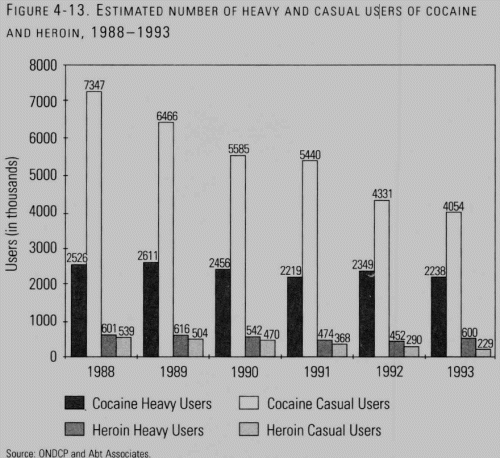
FIGURE 4-13. ESTIMATED NUMBER DF HEAVY AND CASUAL USERS OF COCAINE AND HEROIN, 1988-1993
Source: ONDCP and Abt Associates.
The most obvious casualties of the fad of drug use in the 1960s, 1970s, and 1980s are today's drug addicts. Figure 4-13 reveals that while the drop in casual cocaine use in particular has been rapid -- and thus the source of potential new addicts has been curtailed -- the heavy, addicted cocaine and heroin user populations remained roughly the same size. [66]
Heavy cocaine and heroin users also tend to use a variety of other drugs (marijuana, heroin, sedatives, and others) and alcohol. [67] Both heavy cocaine and heroin users are predominantly male, unmarried (most never married), and most commit crimes and are frequently involved in the criminal justice system. They commit crimes -- including selling drugs -- as a means of income to purchase drugs. But heavy cocaine users in particular also commit crimes as a result of "the effects of the drug itself (they become disinhibited and commit crimes), or because of a life-style choice (they participate in both drug use and criminal activity)." [68]
In one of the more intensive studies of heroin addicts, the Clinton administration's Office of National Drug Control Policy reported: "More users initiated heroin use in 1968, 1969, and 1970 than in any other years .... Twenty-five years after the last heroin epidemic, we are still suffering its effects." This study also reported that "public assistance is a major -- and perhaps the single largest -- source of income for heroin users." [69]
FEEDING WASTE AND MISMANAGEMENT IN THE DRUG TREATMENT BUREAUCRACY
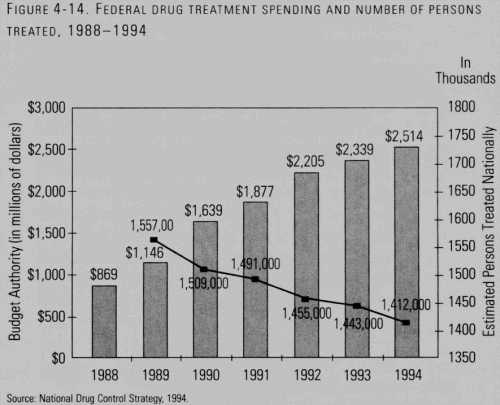
FIGURE 4-14. FEDERAL DRUG TREATMENT SPENDING AND NUMBER OF PERSONS TREATED, 1988-1994
Source: National Drug Control Strategy, 1994.
The Clinton administration began by calling for a reorientation of national drug control efforts focusing on treating hard-core addicts. Some very fine drug treatment programs have proven their usefulness, [70] but the government treatment bureaucracy is manifestly ineffective. The Clinton administration's claim that it will improve the drug problem by increasing treatment slots for hard-core addicts is contradicted by the facts found in the recent record of treatment funding and the number of persons served. [71] As shown in Figure 4-14, although federal drug treatment spending almost tripled between 1988 and 1994, the number of treatment slots remained virtually unchanged and the estimated number of persons treated declined -- from 1,557,000 in 1989 to 1,412,000 in 1994. [72]
Nonetheless, existing treatment capacity, measured in terms of persons served per year, is equivalent to more than half the total estimated number of cocaine and heroin addicts (see Figure 4-15). [73] So it is important to ask: bureaucratic waste and inefficiencies within the treatment system aside, why hasn't the system reduced the number of addicts?
Most addicts have been through treatment more than once. The fact is that drug addicts like using drugs (even though most of them also dislike some aspects and consequences of their drug use). They sometimes admit themselves to treatment programs, not to stop using drugs, but to regain greater control over their drug use. But the overwhelming majority of the addicts entering treatment with the goal of ending their use are coerced to do so by the courts, family members, or an employer. [74]
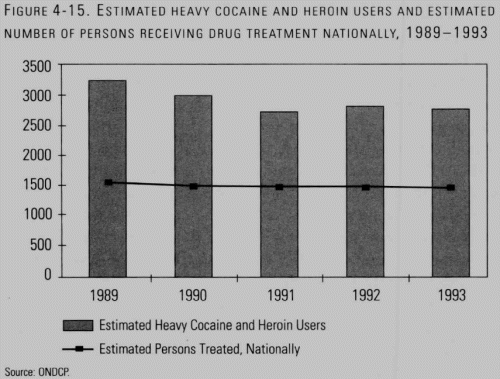
FIGURE 4-15. ESTIMATED HEAVY COCAINE AND HEROIN USERS AND ESTIMATED NUMBER OF PERSONS RECEIVING DRUG TREATMENT NATIONALLY, 1989-1993
Source: ONDCP.
A substantial number of addicts have been through many treatment programs. Some of those programs are simply not effective, but there are insufficient structures monitoring performance to force them out of business. Sometimes addicts and programs are not matched properly. [75] When the cocaine epidemic started, many heroin treatment slots were unfilled, but not enough slots for those needing treatment were tailored for cocaine addiction. Government can, and should, act to increase accountability (insist that programs receiving federal funds demonstrate they are effective) and increase service capacity in target areas, but the federal government is a very blunt and rather slow instrument for getting this done. The federally funded portion of the treatment system is estimated to be less than half the total national spending on drug treatment, and federal measures for accountability and targeting must attempt to reach through multiple layers of bureaucracy -- in the federal government, and in state and local governments.
In addition, more and more of the addict population seems to be a fixed, aging cohort, with a long history of addiction from early adulthood -- so-called hard-core addicts. Many of them are addicted to a variety of drugs and suffer from a range of pathologies, including severe mental disorders. The best treatment programs can still offer some hope of recovery, but it is also likely that for a substantial percentage of the most severely addicted there may be no effective treatment today, particularly if drugs remain widely available.
A long-term study of heroin addicts, published in 1993, highlights this problem in stark terms. Five hundred eighty-one narcotics addicts (most of them heroin addicts) were studied at intervals over 24 years. The group originally entered treatment through a criminal justice program, the California Civil Addict Program, between 1962 and 1964. A 1985-86 follow-up study of this group found that only 25 percent of them tested free of opiates, 6.9 percent were in a program of methadone maintenance (receiving the drug methadone to block the high resulting from heroin use and thus remove the strongest reason for such use), and 27.7 percent (of the group now in their late forties) had died -- and the mortality rate was accelerating. The researchers warn: "The results suggest that the eventual cessation of narcotics use is a very slow process, unlikely to occur for some addicts, especially if they have not ceased use by their late 30's." [76]
Another study of heroin addicts released in November 1994 found:
Only 15 percent of the heroin users in the study (23 of 150) had never participated in substance abuse treatment. Of the 85 percent who had received treatment, one-third (42 of 127) were currently enrolled in a treatment program ....
Among users with treatment experience, the median number of times enrolled in treatment was five. However, more than a fourth reported having been in treatment on more than ten occasions. One user reported 67 treatment experiences. [77]
On August 9, 1993, Clinton administration Drug Policy Director Lee Brown released a research paper, "Characteristics of Heavy Cocaine Users." That study contained a similar, sobering conclusion regarding the success rates of treatment programs for cocaine addicts:
While many users benefit from treatment, compulsive use is most frequently a chronic condition. The Treatment Outcome Prospectives Study (TOPS) showed that for every 10 clients who used cocaine regularly during the year prior to treatment, six clients had returned to heavy use one year after treatment, and eight clients had relapsed into heavy use within three to five years after treatment. These statistics do not accurately reflect the success of treatment outcomes. (The TOPS study is the most recent large-scale study of treatment outcomes. Many smaller scale treatment studies show results with better long-term outcomes.) Nevertheless, the TOPS data suggest that treated cocaine users are more likely than not to return to drug use. [78]
Those who assert that treatment is the answer, and those who advocate legalizing drugs and retrieving those who become addicted by expanding drug treatment, never confront the fact that today a significant portion of those who are addicted to cocaine and heroin will die of that addiction if treatment alone is the principal vehicle society employs to save them.
The 1994 crime bill contained large sums for drug courts. These provisions were highlighted by spokesmen who announced that they were being "smart and tough." The model, and essentially the justification, for this funding was the Miami Drug Court and Attorney General Janet Reno's personal involvement with it as a prosecutor. But in August, as the crime bill fight was near its peak, the Miami Herald published a lengthy report raising serious questions about the effectiveness of the program. [79] In particular, the program established to divert first- and second-time drug offenders into treatment instead of prison was being used by robbers and burglars to serve as little as 45 days. And in December the Herald reported that the chief judge overseeing the Miami Drug Court ordered an audit of the entire program, expressing alarm that it "had no mechanism to measure whether it was succeeding." [80] A central flaw in the rush to embrace drug courts as a major answer to addiction and crime is that a very large number of addicted offenders today are long-term, hard-core addicts who are poorly suited for diversion programs. Drug courts, properly run, hold promise for treating young addicts in the early stages of addiction. But young addicts in the early stages of addiction are not the primary addiction problem. Moreover, drug courts generally depend on the same probation, parole, and pretrial supervision system that is now unable to prevent a third of all violent crime from being committed by individuals under its "custody." These institutions are not a promising source of the close supervision and imposition of sanctions for resorting to drug use or withdrawing from treatment required for drug courts to be effective.
In 1994, two groups of studies were released that purport to demonstrate the effectiveness of drug treatment and its superior cost-effectiveness to all other categories of drug enforcement and supply control. One, funded by the California Department of Alcohol and Drug Programs, received attention for its conclusion that treatment "averages [a] $7 return for every dollar invested." But it included both alcohol and drug addiction and was thus too broad to be enlightening in regard to the cost-effectiveness of treating cocaine, and particularly crack, addiction -- the most destructive addiction threat today. Moreover, the study relied on two sample groups with only a 50 percent and 46 percent response rate. Despite efforts to impute outcomes for nonrespondents from respondents, it is probable that the nonrespondents constitute very high -- with the precise level unmeasured -- treatment failures. [81] In addition, none of the sympathetic news reports noted that such benefits-to-society-for-every-dollar-invested studies for expenditures on prisons and jails have produced estimates as high as 17 to 1. [82]
A second widely reported study was funded in part by the White House drug office, and conducted by the RAND Corporation. It was entitled "Controlling Cocaine," and concluded that "treatment is seven times more cost effective in reducing cocaine consumption than the best supply control program." [83] Most of the press reports on the release of this study failed to mention that even Clinton administration drug office officials participating in the release distanced themselves from the reliability of the methods RAND used to measure the effectiveness of supply control programs. [84] And to our knowledge none of the press reports explained what the study actually found in regard to the effectiveness of programs treating cocaine addicts.
In reviewing all forms of cocaine treatment, RAND reported that 20 percent of addicts continue using drugs while in treatment and only 13.2 percent of the cocaine addicts treated reduce their drug use below weekly or more frequent use (what RAND defined as "heavy use") during the year following their treatment. Overall, RAND reported, only "6 percent of heavy users leave heavy use each year [i.e., to something less than heavy use, not to be equated with no use]. About two-thirds of that outflow is apparently due to existing treatment programs ... [and] one-third of the total annual outflow from heavy use is estimated to be due to unassisted desistance from heavy use." [85]
In other words, overall, the cocaine treatment system was only 4 percent effective in reducing heavy use and only 2 percent more effective in reducing heavy use than no treatment at all. And if effectiveness were measured in terms of the percentage of addicts who stopped using cocaine altogether and for good, the results would have been much worse.
While support for treatment programs should continue, the harsh reality of cocaine and crack addiction is that most addicts -- and most of them are hard-core, long-term addicts today -- are likely to die from the effects of their addiction sometime in their forties, if not earlier. This is yet one more compelling reason why preventing casual drug use by young people -- the first step on the path to addiction -- is so important.
As long as the drug problem is discussed in terms of treatment versus enforcement or supply versus demand, it will remain fundamentally misguided. These positions are at odds with both reality and common sense. An effective drug policy should begin with this assumption: as long as young people and those who receive treatment reside in communities where the supply of dangerous, addictive drugs remains plentiful -- i.e., where there is de facto legalization -- prevention and particularly treatment efforts will be severely undercut and, for purposes of national policy, not very effective.
THE ILLEGAL DRUG TRADE, SUPPLY REDUCTION, AND ADDICTION
What is increasingly an addict-driven trade today is still dominated by cocaine, as can be seen in Figure 4-16.86 Roughly three-fifths of the total spent on illegal drugs is spent on cocaine -- and for the most part, that means crack.
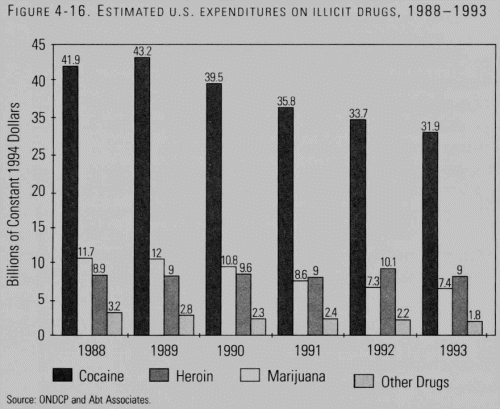
FIGURE 4-16. ESTIMATED U.S. EXPENDITURES ON ILLICIT DRUGS, 1988-1993
Source: ONDCP and Abt Associates.
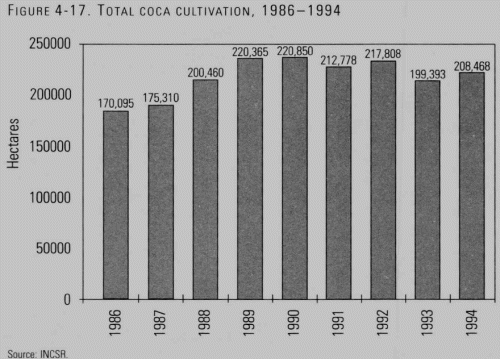
FIGURE 4-17. TOTAL COCA CULTIVATION, 1986-1994
Source: INCSR.
As can be seen in Figure 4-17, working with cocaine source countries (Colombia, Peru, and Bolivia) on reducing coca87 crops stopped the increase in cultivation that occurred during the 1980s, but did not substantially reduce the crop size.88 Eradication of the plants from which illegal drugs are extracted was a principal emphasis of U.S. anti-drug policy in the 1980s. It produced disappointing results, however. Since 1987, eradication efforts in cocaine source countries have produced less than a 10 percent reduction in estimated potential cocaine production, and it only came close to 10 percent in one year -- 1992 (see Figure 4-18).
Much more encouragingly, interdiction of cocaine within the source countries and in transit from them to the United States has substantially reduced the amount of cocaine available to American markets. What could arrive, based on what could be produced, minus what was seized, declined between 1989 and 1992 (see Figure 4-19). [89] Seizures within South America increased dramatically, and U.S. assistance, particularly military detection and tracking assistance, supported interdiction throughout the hemisphere.
In 1992, half or more of potential cocaine production was seized (see Figure 4-20). Not only did interdiction stop almost twice as much cocaine as that actually consumed, supply reduction efforts actually seem to have contributed to a reduction in cocaine emergency room cases and a reduction in the population of cocaine addicts.
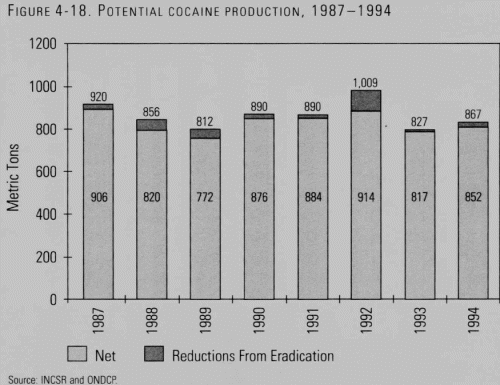
FIGURE 4-18. POTENTIAL COCAINE PRODUCTION, 1987 -1994
Source INCSR and ONDCP.
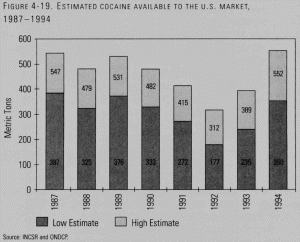
FIGURE 4-19. ESTIMATED COCAINE AVAILABLE TO THE U.S. MARKET, 1987-1994
Source: INCSR and ONDCP.
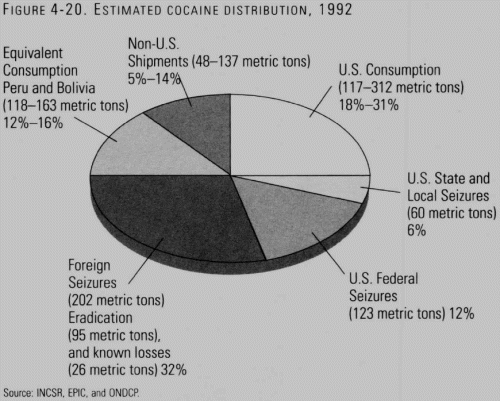
FIGURE 4-20. ESTIMATED COCAINE DISTRIBUTION, 1992
Source: INCSR, EPIC, and ONDCP
The Colombian government's broad and intense attack on the cocaine cartel produced a substantial disruption in the cocaine supply to the United States from the very end of 1989 into 1991, although there are no exact measures of the magnitude of that disruption (and the previous estimates of potential production cannot fully capture it). Nonetheless, there are important indicators of significant disruption with beneficial consequences, particularly for heavy cocaine users.
The U.S. Drug Enforcement Administration's data on cocaine prices throughout the nation reveal (see Figure 4-21) that in gram amounts -- the accepted retail quantity -- the downward trend in prices and upward trend in purity through early 1989 abruptly reversed. [90] The magnitude of this change in availability is perhaps best represented by using a standardized price, that is, by calculating the cost of a 100 percent pure gram of cocaine at each point of measurement. [91] And this reduction in the availability of cocaine -- driving the price up and the purity down -- coincided with a 27 percent reduction in cocaine emergency room cases between 1989 and 1990, as can be seen in Figure 4-22. [92]
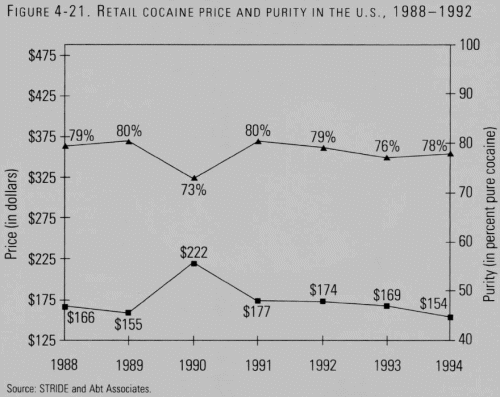
FIGURE 4-21. RETAIL COCAINE PRICE AND PURITY IN THE U.S., 1988-1992
Source: STRIDE and Abt Associates.
Medical examiner reports of deaths related to cocaine use during this period also declined. Analysis has found cocaine price increases, purity reductions, and declines in cocaine emergency room cases, deaths, and cocaine use among arrestees for all the more than 20 largest U.S. cities for which the data are available. [93] Further, this cocaine supply reduction also coincides with the estimated decline in number of heavy cocaine users previously cited. [94]
What conclusions can we draw based on the limited available data? The reduction in cocaine availability seems beyond question, and that it was a causal factor in the decline in cocaine use, particularly heavy use, is the most obvious and reasonable conclusion in light of the data. But this cannot be proven with the precision that might be demanded in circumstances where the available data were more extensive.
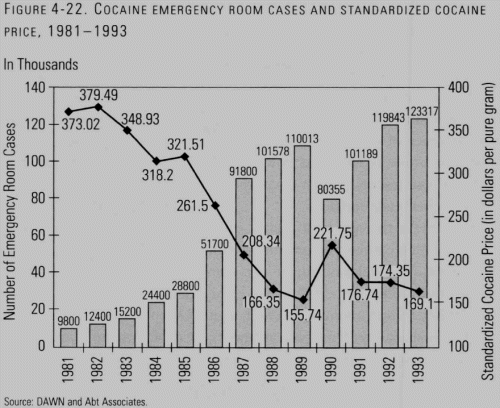
FIGURE 4-22. COCAINE EMERGENCY ROOM CASES AND STANDARDIZED COCAINE PRICE, 1981-1993
Source: DAWN and Abt Associates.
Second, while nonaddictive users consume a much smaller quantity of cocaine than heavy or addicted users, an almost 80 percent drop in nonaddictive users between 1985 and 1992 certainly reduced demand in a significant, if limited, extent (which is not measurable by existing surveys and analyses). In order to increase cocaine retail prices and reduce purity, supply-reduction efforts would have to cut supply beyond the amount that would have satisfied the reduced demand. So the actual supply disruption may be even greater than the change in the price and purity data. [95]
Finally, such analysis must consider whether cocaine traffickers may have manipulated supply to increase profits or for some other purpose. In fact, in smaller transactions and at the wholesale level in particular areas, law enforcement investigators have reported efforts by particular groups to influence prices by withholding supply, but these have been limited in both scope and duration. There is no evidence of either large-scale efforts to manipulate availability or the ability to do so.
If measured strictly by results, our national prevention efforts produced impressive achievements -- dramatic declines in casual cocaine use in particular -- and, contrary to conventional opinion, interdiction and cocaine source-country programs seem to have been a crucial factor in the reductions in heavy or addictive cocaine use.
Why didn't the reduction in cocaine supply continue throughout 1991 and beyond? The movement of U.S. military resources to the Persian Gulf for Desert Shield and then Desert Storm, beginning in the summer of 1991, reduced interdiction coverage, particularly in regard to some of the most powerful airborne and surface naval systems. Those resources were never returned and interdiction resources were slashed even further.
We believe the supply of drugs -- measured in their retail price and purity (which can be stated as their standardized price as cited above) -- bears a direct relationship to the number of people who will enter emergency rooms with drug-related emergencies, not only for cocaine, but for heroin and marijuana as well, as can be seen in Figures 4-23 and 4-24. [96] In short, greater supply at lower cost means greater demand. It is the economics of mass, discount marketing.
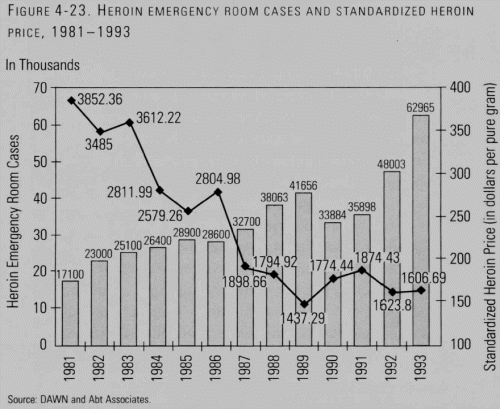
FIGURE 4-23. HEROIN EMERGENCY ROOM CASES AND STANDARDIZED HEROIN PRICE, 1981-1993
Source: DAWN and Abt Associates.
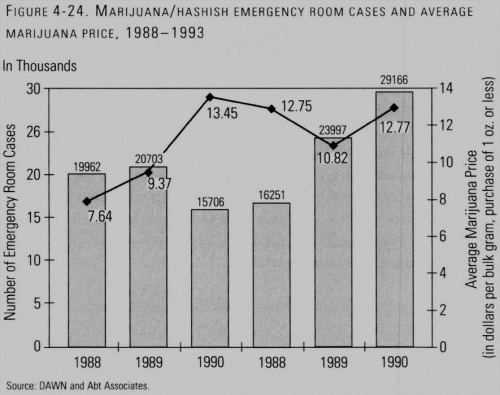
FIGURE 4-24. MARIJUANA/HASHISH EMERGENCY ROOM CASES AND AVERAGE MARIJUANA PRICE, 1988-1993
Source: DAWN and Abt Associates
PRIORITIES FOR EFFECTIVE ACTION
TEACH THE YOUNG THAT DRUG USE IS WRONG
Preventing young people from using drugs is central to all effective anti-drug efforts. After all, young people who do not use drugs in their teens are unlikely to ever do so as adults. But each generation must be taught that illegal drug use is wrong. And this lesson must be taught by the community of adults. Specifically, children learn about drugs by what the adults around them say and do. Parents teach by precept and example. The same is true of schools and the communities. If drug use and sale is not aggressively opposed and prevented, children learn it is acceptable, despite what some adults may occasionally tell them. It will always fall to parents to provide that education in the home and to ensure that schools and their communities are teaching this lesson effectively. This task is easier, of course, if national leaders set the right example and speak in support of parents. But parents, churches, schools, youth organizations, and communities have always been, and will always remain, the first -- and most important -- line of defense.
PUT OPEN-AIR DRUG MARKETS OUT OF BUSINESS
Open-air drug markets feed addiction and are a visible sign of the toleration of the drug trade in our nation. Aggressive street-level policing can force drug dealers from open spaces and make their lives more difficult and dangerous -- and hence their activities less frequent. Many communities have demonstrated that creating a law enforcement presence and maintaining it in response to relocation efforts by drug dealers is doable -- but only if closing drug markets is made a priority. Decisive action can and should be taken by local officials and community members immediately.
SANCTION FOREIGN NATIONS THAT ARE THE SOURCE OF DRUGS
The federal government can also do what no parent or local community can: diminish the flow of drugs reaching local communities.
The United States regularly threatens and initiates trade sanctions to protect business interests -- to protect copyrights and force foreign nations to open their markets to American goods, for example. We believe there are more compelling reasons to use trade sanctions to protect American young people from drugs. Those who properly support the goal of free trade ought to recognize that their goal cannot be defended if free trade means accepting the drug trade.
America needs once again to forge an anti-drug partnership with Colombia and other Latin American nations. [97] Otherwise the cartels' grip on Colombia will not only tighten, but the leaders of the drug trade will grow stronger in many nations of South America and in Mexico. The cartels are moving rapidly toward the goal of ending all threat of serious enforcement action against their operations in this hemisphere, outside the United States. And Americans will face a virtually unrestricted flow of cocaine, heroin, and marijuana -- at lower and lower prices and higher and higher purities.
Only the threat and, if necessary, the imposition of trade sanctions will mobilize the legitimate interests in the Latin American nations to force their governments to attack drug trafficking seriously.
MAKE INTERDICTING DRUGS A TOP NATIONAL SECURITY PRIORITY
It is time to put the U.S. military in charge of stopping the flow of illegal drugs from abroad. Law enforcement agencies currently responsible for drug interdiction should be placed under the overall command and control of the military. We realize that some in the military will object to this nontraditional mission and its cost. And some inside and outside the military will object to what they will call the "militarization" of the drug war. Those are legitimate concerns. But the fact is, no law enforcement organization will ever have the intelligence-gathering resources, radar, tracking, and apprehension capabilities for the interdiction task that the military already possesses. Those military capabilities should be dedicated in a much larger, more sustained, and integrated manner to the interdiction mission -- with the military in charge of that mission outside our borders. The national security capabilities of a superpower give the United States overwhelming superiority over even the richest and most ruthless drug lords. Yet this superiority remains substantially unused. The drug trade -- in the magnitude that it exists today -- can only operate if the federal government fails to apply the national security resources to cripple it.
DESTROY THE MAJOR DRUG-TRAFFICKING ORGANIZATIONS OPERATING WITHIN THE UNITED STATES
The drug trade inside the United States relies on sophisticated senior management. Despite periodic law enforcement successes, federal domestic enforcement agencies have produced no disruption of major trafficking operations and no sustained reductions in availability. This needs to change.
Right now federal drug enforcement lacks sufficient accountability. This could change by requiring the attorney general to prepare a report every six months identifying all major drug-trafficking organizations known to be operating in the United States [98] and a plan to deploy federal enforcement personnel to dismantle them. Congress can even impose such a policy by making funds for federal drug enforcement agencies contingent on effectively implementing it.
Most Americans' opinions about the drug problem conform remarkably to the best available research. Americans have remained steadfast in their opposition to drugs despite the arguments advanced by legalization advocates. But that steadfast conviction must be conveyed more forcefully -- particularly to today's young people. To put it another way: the issue is less about public opinion (which is strongly against drug use) than the intensity of that opinion and how well (or poorly) it translates throughout society. The majority of the American public rightly believes that drugs are a cause of moral poverty, often destroying the strongest human bonds of love and affection -- among parents and children, husbands and wives -- in their wake. The majority of the public is right, too, in its conviction that drugs feed and intensify violent crime. The key here as elsewhere, of course, is to act on that conviction. We know what needs to be done -- at the level of the federal and state governments, within communities, in our schools, and in individual lives. A successful and serious anti-drug effort will require once again taking up the proven, purposeful, and successful steps we have taken in the past.

